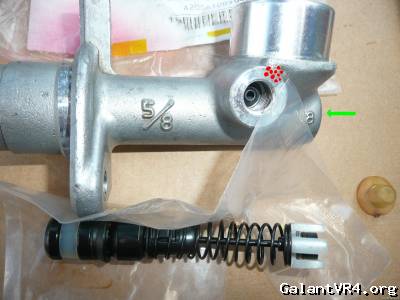Justin,
Are you trying to bleed the clutch hydraulics while the front of the car is up on stands?

The green line is the thermal compensating port where fluid can enter/leave the master cylinder bore from the reservoir.

That's the comp port at the bottom of the bore.
Note it is on the centerline of the bore, leaving a "pocket" area where air can be trapped above it and in front of the side port.
Most of that air will be purged when the piston displaces fluid out and into the system thru the side port that leads out to the slave during the beeding proccess.
... However, some will be trapped there, (red "bubbles" in top pic... doan b hatin on my paint skillz ... /ubbthreads/images/graemlins/grin.gif )
...
especially if you have the nose of the car up on stands, ... and it can be a real bitch to get it all out ...
Even a small amount of trapped air can contribute to release issues
This is why I always recommend folks bench bleed their components beofre they install them on the vehicle. You can optimise the angle, and give the air a high point to leave the system, and in just a couple of strokes, remove
all the air from the master.
A vacuum bleeder can do a workman like job working the air down and out the slave bleeder, but it;s hard to tell when you;re done becuase air "sneaks" down the bleeder screw threads and shows up in the fluid stream, making it look like the systen is still chock full 'o air.
Letting the system "gravity out" for a few minutes will show when things are good to go.
It's also why on installed compnents, I prefer reverse bleeding the system from the slave upwards/back towards the master with the phoenix style bleeder. (it pumps fluid into the system at the slave bleeder screw, and you remove the flushed fluid from the master cylinder reservoir.) The air will head up easier than it heads down, and you can monitor your progress up at the reservoir. When the bubbles stop, you;re golden!